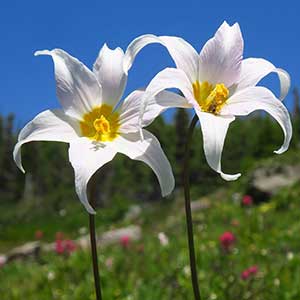Erythronium montanum
Erythronium albidum
avalanche-lily, white avalanche-lily, white glacier lily
white fawnlily, white trout-lily
narrowly ovoid, 25–60 mm.
ovoid, 15–30 mm;
stolons 1–3, mostly on 1-leaved, nonflowering plants; flowering plants reproducing vegetatively by offshoots or droppers.
10–20 cm;
blade green, ovate to broadly lanceolate, base ± abruptly narrowed to petiole, margins wavy.
8–22 cm;
blade green, irregularly mottled, elliptic-lanceolate to ovate-lanceolate or elliptic, ± flat, glaucous, margins entire.
12–35 cm.
7–20 cm.
1–3-flowered.
1-flowered.
tepals white to creamy white with bright yellow zone at base, broadly ovate to broadly lanceolate, 25–45 mm, inner wider than outer, auriculate at base, length less than 4 times width;
stamens 12–24 mm;
filaments white, linear, slender, less than 0.8 mm wide;
anthers bright yellow;
style white, 13–25 mm;
stigma with slender, usually recurved lobes 1–5 mm.
tepals strongly reflexed at anthesis, white, tinged pink, blue, or lavender abaxially, with yellow adaxial spot at base, lanceolate, 22–40 mm, auricles absent;
stamens 10–20 mm;
filaments yellow, lanceolate;
anthers yellow;
pollen yellow;
style white, 15–25 mm;
stigma lobes recurving, 1.5 mm.
oblong, 3–6 cm.
held erect at maturity, obovoid, 10–22 mm, apex rounded to faintly apiculate or umbilicate.
= 24.
= 44.
Erythronium montanum
Erythronium albidum
This species occurs in the Coast Ranges of southern British Columbia, and disjunctly to southern Vancouver Island, the Olympic Peninsula, and Cascade Mountains from Mount Rainier National Park in Washington to central Oregon.
(Discussion copyrighted by Flora of North America; reprinted with permission.)
Erythronium albidum often forms extensive colonies in which nonflowering, 1-leaved plants far outnumber flowering, 2-leaved ones. It is very widespread in eastern North America, more common in the central states than E. americanum and often occurs in slightly drier sites.
(Discussion copyrighted by Flora of North America; reprinted with permission.)


